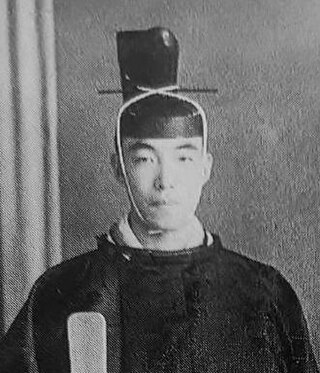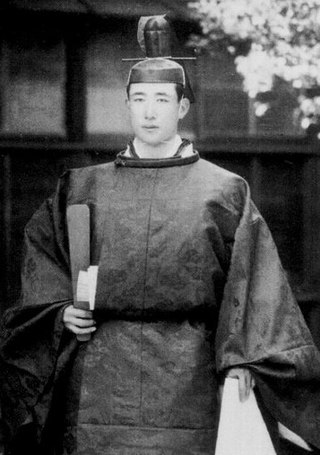
Naruhiko, Prince Higashikuni was a member of the Japanese imperial family and general of the army who served as prime minister of Japan from 17 August to 9 October 1945. He is the only member of the Japanese imperial family to head a cabinet, and Japan's shortest-serving prime minister, serving for only 54 days.

Prince Yasuhiko Asaka was the founder of a collateral branch of the Japanese Imperial Family and a general in the Imperial Japanese Army during the Japanese invasion of China and the Second World War. He was the son-in-law of Emperor Meiji and uncle by marriage of Emperor Hirohito. As the commander of Japanese forces outside Nanjing in December 1937, Asaka presided over the mass murder of hundreds of thousands of Chinese soldiers and civilians in what came to be known as the Nanjing Massacre.

Morimasa, Prince Nashimoto was a member of the Japanese Imperial Family and a field marshal in the Imperial Japanese Army. An uncle-in-law of Hirohito, an uncle of his consort, Empress Kōjun, and the father-in-law of Crown Prince Euimin of Korea, Prince Nashimoto was the only member of the Imperial Family arrested for war crimes during the Allied occupation of Japan following defeat in the Second World War.

Kuniyoshi, Prince Kuni was a member of the Japanese imperial family and a field marshal in the Imperial Japanese Army during the Meiji and Taishō periods. He was the father of Empress Kōjun, and therefore, the maternal grandfather of Emperor Emeritus Akihito and great grandfather of Emperor Naruhito.

The Miyake were branches of the Japanese imperial family created from branches of the Fushimi-no-miya house, the last surviving Shinnōke cadet branch. All but two of these ōke were formed by the descendants of Prince Fushimi Kuniie. The ōke were stripped of their membership in the imperial family by the American Occupation Authorities in October 1947, as part of the abolition of 11 collateral branches with 51 members. After that point, only the immediate family of Emperor Shōwa and those of his three brothers retained membership in the imperial family. However, unofficial heads of these collateral families still exist for most and are listed herein.

Asahiko, Prince Kuni was a member of a collateral line of the Japanese imperial family who played a key role in the Meiji Restoration. Prince Asahiko was an adopted son of Emperor Ninkō and later a close advisor to Emperor Kōmei and Emperor Meiji. He was the great-great-grandfather of the present Emperor of Japan, Naruhito.

Prince Kaya Kuninori was a member of the Japanese imperial family and the founder of one of the nine ōke in the Meiji period.

Morihiro Higashikuni, formerly Prince Morihiro was an Imperial Japanese Army officer who was a member of a cadet line of the Japanese imperial family, grandson of Emperor Meiji and husband of Shigeko Higashikuni, eldest child of Emperor Hirohito and Empress Kōjun.

Sadanaru, Prince Fushimi was the 22nd head of the Fushimi-no-miya shinnōke. He was a field marshal in the Imperial Japanese Army.

Prince Tsunehisa Takeda was the founder of the Takeda-no-miya collateral branch of the Japanese Imperial Family.

Prince Kitashirakawa Yoshihisa of Japan, was the second head of a collateral branch of the Japanese imperial family. He was formerly enshrined in Tainan-Jinja, Taiwan, under the name Kitashirakawa no Miya Yoshihisa-shinnō no Mikoto as the main and only deity.

Prince Nagahisa Kitashirakawa of Japan, was the 4th head of the Kitashirakawa-no-miya collateral branch of the Japanese imperial family and a career officer in the Imperial Japanese Army.

Shigeko Higashikuni, born Shigeko, Princess Teru, was the wife of Prince Morihiro Higashikuni and eldest daughter of Emperor Shōwa and Empress Kōjun. She was the eldest sister to Emperor Emeritus Akihito, and paternal aunt to Emperor Naruhito.
The current line of succession to the Chrysanthemum Throne is based on the Imperial Household Law. At present, only direct male-line males are allowed to ascend the throne.

Kuniie, Prince Fushimi was Japanese royalty. He was the 20th/23rd prince head of the House of Fushimi and the eldest son of Prince Fushimi Sadayuki (1776–1841) and his concubine Seiko, which made him the 11th cousin of Emperor Sakuramachi. Despite being merely a distant cousin to the emperors, he was adopted by Emperor Kōkaku as a son in 1817, which made him a full prince of the blood just like an emperor's natural-born son.

Toshiko Higashikuni, born Toshiko, Princess Yasu, was the fourteenth child and ninth daughter of Emperor Meiji of Japan, and the seventh child and fifth daughter of Sono Sachiko, the Emperor's fifth concubine.

Masako, Princess Takeda, born Masako, Princess Tsune, was the tenth child and sixth daughter of Emperor Meiji of Japan, and the third child and second daughter of Sono Sachiko, the Emperor's fifth concubine.

Fusako Kitashirakawa, born Fusako, Princess Kane, was the eleventh child and seventh daughter of Emperor Meiji of Japan, and the fourth child and third daughter of Sono Sachiko, the Emperor's fifth concubine.

Nobuko, Princess Asaka, born Nobuko, Princess Fumi, was the twelfth child and eighth daughter of Emperor Meiji of Japan, and the fifth child and fourth daughter of Sono Sachiko, the Emperor's fifth concubine.

Sono Sachiko (園祥子) was the fifth concubine of Emperor Meiji of Japan. Although Meiji was the last Japanese emperor to have more than one consort, the official role at court was not abolished until 1924; surviving concubines remained as members of the imperial family in retirement.


























